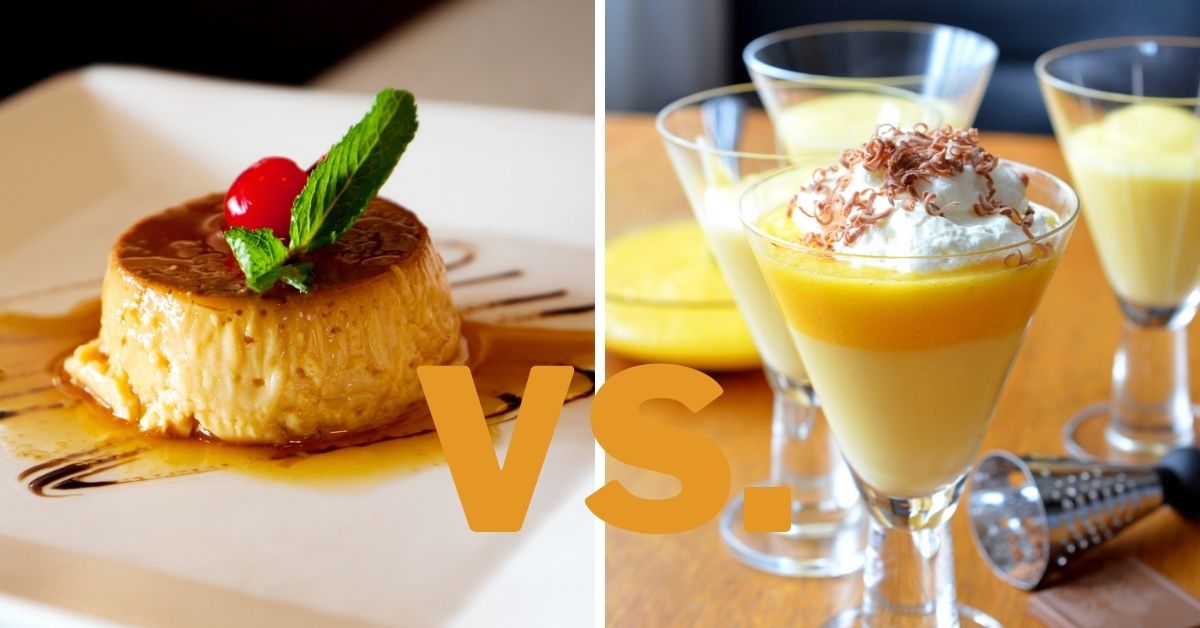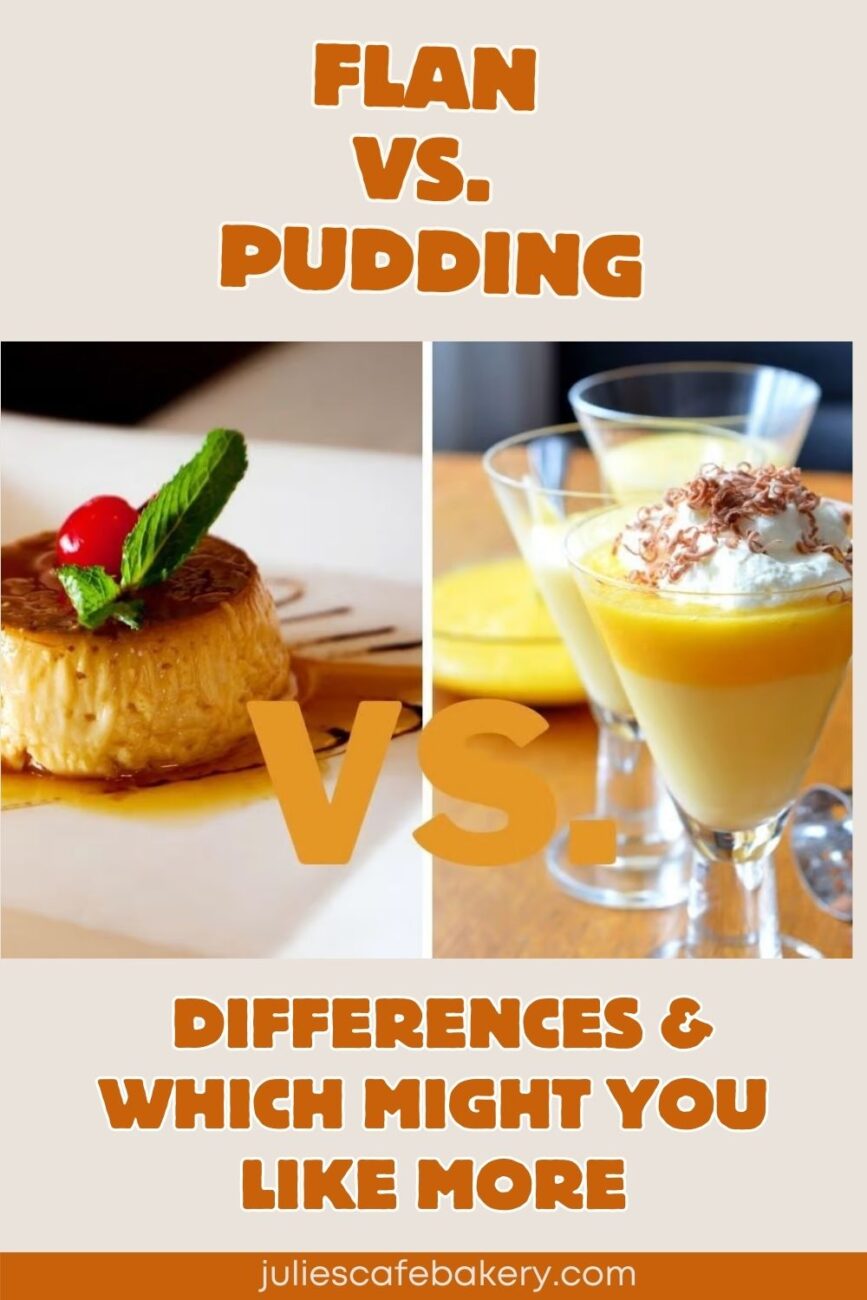Flan vs. Pudding: Differences (& Which Might You Like More)

When it comes to eating desserts typically associated with holidays and warm memories of home, nothing beats a cup of pudding or a delicious slice of caramel flan. A nice old-fashioned custard or a delectable pudding can feel like the ultimate luxury, yet we frequently get confused about the difference between the two desserts.
Flan is a custard made with eggs, sugar, and milk that is cooked in a container with a caramelized sugar bottom. Pudding is a sort of dish with a texture similar to mousse but thickened with some kind of starch, and it doesn’t typically include caramel. While flan is baked in the oven, pudding is cooked on a stove.
We enjoy the creamy, sweet flavors of flans and puddings, but do you know the differences between these dessert staples? Don’t worry, I’m here to clear things up once and for all. 🙂
Pudding
If we were to define pudding, we would not be talking about the fast, boxed pudding that is stirred with cold milk, even though these simple mixes do produce gorgeous and wonderful desserts in their own right. We’re sticking to real puddings here—the comfortable, old-fashioned dessert that our grandmas made whenever possible, and which evokes childhood memories.
A genuine pudding is made with a sweetened milk or cream base that is thickened with a gelatinized starch, commonly cornstarch or flour, and cooked in a saucepan on the stove. This classic dish is extremely versatile, as it may be used in a trifle, a parfait, or simply eaten on its own.
People most commonly prefer traditional pudding tastes such as vanilla and chocolate. However, if you’re feeling adventurous, you can try some fresh flavors like pumpkin or mochaccino.
Flan
Flan has its origins in Ancient Rome, where eggs and milk were cooked together and frequently topped with something sweet, such as honey. The idea soon made its way to Spain, where cooking the mixture in a caramelized sugar mold became customary.
Flan was brought to Latin America during the Spanish conquest, and it has since become a highly cherished meal among various nations across the continent.
Flan can be defined as either a baked custard dessert topped with caramel, comparable to the French crème caramel, or a tart-like sweet pastry with a filling known as a fruit flan. It can be made in many ways, but eggs, dairy, and sugar are stapled ingredients.
Alternatively, sweetened condensed milk, cream, as well as flavorings such as vanilla, citrus, coconut, or coffee can be added as well.

Differences between flan and pudding
One of the biggest differences between flan and pudding is regarding eggs as an ingredient. Flan is primarily an egg custard with a strong egg and dairy flavor, even though egg replacements are occasionally used. It may or may not contain additional flavor extracts, but in all cases, the custard stays eggy. On the other hand, pudding typically does not contain eggs, but it is almost always flavored, even if the said flavor is just vanilla.
Flans and puddings also differ in terms of the time it takes to set. The most important component of making flan at home is to be patient and allow it to chill in the fridge for at least 8 hours.
Therefore, making flan a day ahead of time (or up to three days ahead) ensures that it is perfectly set and ready to serve. After you make homemade pudding, you should leave it in the fridge for about two hours, or until it gets really cold.
However, if you crave something sweet but are not willing to wait that long, you can even eat it after 15 minutes.
Pudding can be easily served in the dish you made it in, perhaps topped with a bit of whipped cream. In contrast, serving flan takes some skill, because you need to loosen the flan by gently shaking it and overturning it onto a plate using a small sharp knife against the mold’s lid. It’s also important to carefully remove the .ramekin from the flan, allowing the caramel syrup to flow over it.
Finally, the process of flan-making starts with cooking sugar until it melts and turns a deep brown, and then pouring the hot syrup into the baking dish so it coats the bottom of the mold evenly.
After adding the egg mixture, custard cups or a baking dish are partially submerged in a boiling water bath to bake for about an hour.
Pudding is significantly easier to make and takes less time, with typical cooking time being approximately 10 to 15 minutes.
Flan or pudding: Which might you like more?
Choosing between these two mouth-watering sweets can be a really hard task, and it has a lot to do with your preferences. While flan is probably a better alternative if you want something creamy and sugary, pudding is your dessert of choice if you have less time to spend in the kitchen, or if you are allergic to eggs.
So, what’s the final verdict? It depends on your personal taste and dietary preferences, but you can’t go wrong with choosing any of the above-mentioned options. Whether you’re throwing an upscale dinner party or looking for the perfect finish to a weeknight meal, pudding and flan are always a success!
